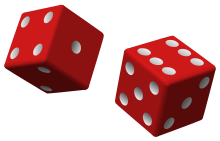
Back توليد الأعداد العشوائية Arabic Təsadüfi ədəd generatoru Azerbaijani দৈব পরীক্ষা Bengali/Bangla Generació de nombres aleatoris Catalan Generátor náhodných čísel Czech تولید اعداد تصادفی Persian Générateur de nombres aléatoires French यादृच्छिक संख्या जनित्र Hindi Pembangkitan bilangan acak ID Generatore di numeri casuali Italian

Random number generation is a process by which, often by means of a random number generator (RNG), a sequence of numbers or symbols is generated that cannot be reasonably predicted better than by random chance. This means that the particular outcome sequence will contain some patterns detectable in hindsight but impossible to foresee. True random number generators can be hardware random-number generators (HRNGs), wherein each generation is a function of the current value of a physical environment's attribute that is constantly changing in a manner that is practically impossible to model. This would be in contrast to so-called "random number generations" done by pseudorandom number generators (PRNGs), which generate numbers that only look random but are in fact predetermined—these generations can be reproduced simply by knowing the state of the PRNG.[1]
Various applications of randomness have led to the development of different methods for generating random data. Some of these have existed since ancient times, including well-known examples like the rolling of dice, coin flipping, the shuffling of playing cards, the use of yarrow stalks (for divination) in the I Ching, as well as countless other techniques. Because of the mechanical nature of these techniques, generating large quantities of sufficiently random numbers (important in statistics) required much work and time. Thus, results would sometimes be collected and distributed as random number tables.
Several computational methods for pseudorandom number generation exist. All fall short of the goal of true randomness, although they may meet, with varying success, some of the statistical tests for randomness intended to measure how unpredictable their results are (that is, to what degree their patterns are discernible). This generally makes them unusable for applications such as cryptography. However, carefully designed cryptographically secure pseudorandom number generators (CSPRNGS) also exist, with special features specifically designed for use in cryptography.
- ^ Lugrin, Thomas (2023), Mulder, Valentin; Mermoud, Alain; Lenders, Vincent; Tellenbach, Bernhard (eds.), "Random Number Generator", Trends in Data Protection and Encryption Technologies, Cham: Springer Nature Switzerland, pp. 31–34, doi:10.1007/978-3-031-33386-6_7, ISBN 978-3-031-33386-6